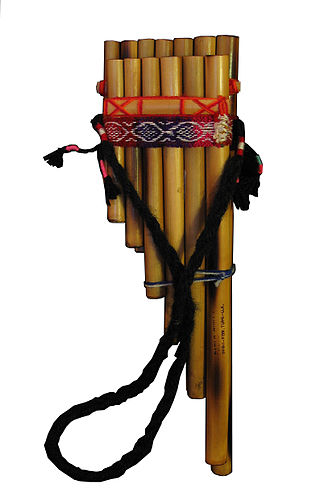
Gheorghe Zamfir is a Romanian nai musician.

A pan flute is a musical instrument based on the principle of the closed tube, consisting of multiple pipes of gradually increasing length. Multiple varieties of pan flutes have been popular as folk instruments. The pipes are typically made from bamboo, giant cane, or local reeds. Other materials include wood, plastic, metal, and clay.

Jean-Pierre Louis Rampal was a French flautist. Rampal popularised the flute in the post–World War II years, recovering flute compositions from the Baroque era, and spurring contemporary composers, such as Francis Poulenc, to create new works that have become modern standards in the flautist's repertoire.

Emmanuel Pahud is a Franco-Swiss flautist.
In Greek mythology, Syrinx was a nymph who was transformed into water reeds that were then fashioned into a musical instrument by the god Pan.

Constantin "Dinu" Lipatti was a Romanian classical pianist and composer whose career was cut short by his death from effects related to Hodgkin's disease at age 33. He was elected posthumously to the Romanian Academy. He composed few works, all of which demonstrated a strong influence from Bartok.

George Enescu, known in France as Georges Enesco, was a Romanian composer, violinist, pianist, conductor, and teacher and is regarded as one of the greatest musicians in Romanian history.

The Suzuki method is a mid-20th-century music curriculum and teaching method created by Japanese violinist and pedagogue Shinichi Suzuki. The method claims to create a reinforcing environment for learning music for young learners.

Taraful Haiducilor are a Romanian-Romani taraf from Clejani, Romania, and one of the most prominent such groups in post-Communist era Romania. In the Western world they have become known by the name given to them in French-speaking areas, where they are known as Taraf de Haïdouks.

Murray David Perahia is an American pianist and conductor. He has been considered one of the greatest living pianists. He was the first North American pianist to win the Leeds International Piano Competition, in 1972. Known as a leading interpreter of Bach, Handel, Scarlatti, Mozart, Beethoven, and Schumann, among other composers, Perahia has won numerous awards, including three Grammy Awards from a total of 18 nominations, and 9 Gramophone Awards in addition to its first and only "Piano Award".

Clara Haskil was a Romanian classical pianist, renowned as an interpreter of the classical and early romantic repertoire. She was particularly noted for her performances and recordings of Mozart. She was also a noted interpreter of Beethoven, Schumann, and Scarlatti.
Syrinx, L. 129, is a piece of music for solo flute which Claude Debussy wrote in 1913. It generally takes three minutes or less to perform. It was the first significant piece for solo flute after the Sonata in A minor composed by C. P. E. Bach over 150 years before (1747), and it is the first such solo composition for the modern Böhm flute, developed in 1847.

Ransom Wilson is an American flutist, conductor, and educator.

Claude-Paul Taffanel was a French flautist, conductor and instructor, regarded as the founder of the French Flute School that dominated much of flute composition and performance during the mid-20th century.

The nai is a traditional Romanian diatonic pan flute used in a lot of genres.
Damian Drăghici is a Romanian musician of Romani origin.

Valentin Radu is founder, artistic director and conductor of Vox Ama Deus, with performances at the Kimmel Center in Philadelphia and other various city, suburban, and Main Line area venues, has led numerous orchestras and vocal ensembles in Europe and the U.S., including the Hungarian National Philharmonic, Bucharest, Arad, Oradea Philharmonics, the Budapest Chamber Orchestra and the Romania National Radio Orchestra. In 1996 he conducted the Bucharest Philharmonic in Handel's Messiah, and in 1997 led the Romanian National Radio Orchestra in Handel's Acis and Galatea.
Mindru Katz was a Romanian-Israeli classical pianist.
Ion Miu is a virtuoso cimbalom player, performing both Romanian folk music and pieces from the classical repertoire.

Events from the year 2010 in Romania.














